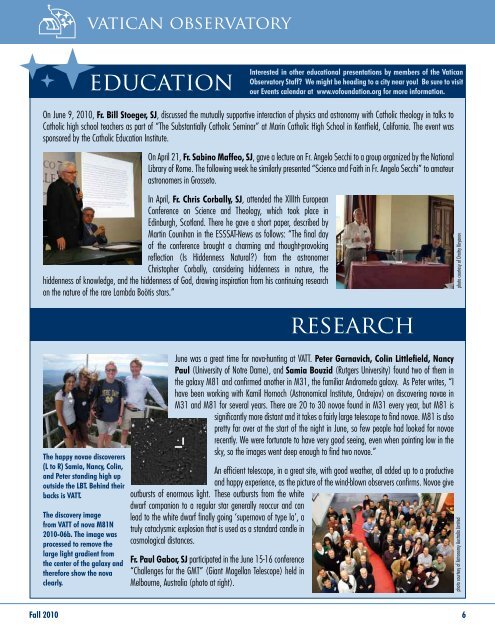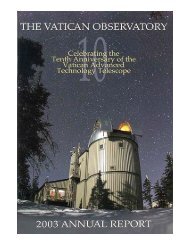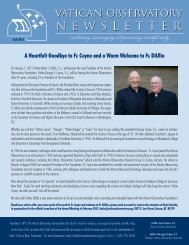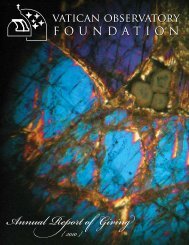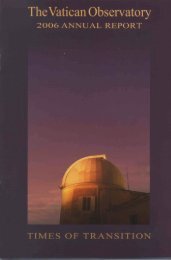Newsletter Fall 2010 - Vatican Observatory
Newsletter Fall 2010 - Vatican Observatory
Newsletter Fall 2010 - Vatican Observatory
You also want an ePaper? Increase the reach of your titles
YUMPU automatically turns print PDFs into web optimized ePapers that Google loves.
vatican observatoryeducationInterested in other educational presentations by members of the <strong>Vatican</strong><strong>Observatory</strong> Staff? We might be heading to a city near you! Be sure to visitour Events calendar at www.vofoundation.org for more information.On June 9, <strong>2010</strong>, Fr. Bill Stoeger, SJ, discussed the mutually supportive interaction of physics and astronomy with Catholic theology in talks toCatholic high school teachers as part of “The Substantially Catholic Seminar’’ at Marin Catholic High School in Kentfield, California. The event wassponsored by the Catholic Education Institute.On April 21, Fr. Sabino Maffeo, SJ, gave a lecture on Fr. Angelo Secchi to a group organized by the NationalLibrary of Rome. The following week he similarly presented “Science and Faith in Fr. Angelo Secchi” to amateurastronomers in Grosseto.In April, Fr. Chris Corbally, SJ, attended the XIIIth EuropeanConference on Science and Theology, which took place inEdinburgh, Scotland. There he gave a short paper, described byMartin Counihan in the ESSSAT-News as follows: “The final dayof the conference brought a charming and thought-provokingreflection (Is Hiddenness Natural?) from the astronomerChristopher Corbally, considering hiddenness in nature, thehiddenness of knowledge, and the hiddenness of God, drawing inspiration from his continuing researchon the nature of the rare Lambda Boötis stars.”photo courtesy of Dmitry KiryanovThe happy novae discoverers(L to R) Samia, Nancy, Colin,and Peter standing high upoutside the LBT. Behind theirbacks is VATT.The discovery imagefrom VATT of nova M81N<strong>2010</strong>-06b. The image wasprocessed to remove thelarge light gradient fromthe center of the galaxy andtherefore show the novaclearly.researchJune was a great time for nova-hunting at VATT. Peter Garnavich, Colin Littlefield, NancyPaul (University of Notre Dame), and Samia Bouzid (Rutgers University) found two of them inthe galaxy M81 and confirmed another in M31, the familiar Andromeda galaxy. As Peter writes, “Ihave been working with Kamil Hornoch (Astronomical Institute, Ondrejov) on discovering novae inM31 and M81 for several years. There are 20 to 30 novae found in M31 every year, but M81 issignificantly more distant and it takes a fairly large telescope to find novae. M81 is alsopretty far over at the start of the night in June, so few people had looked for novaerecently. We were fortunate to have very good seeing, even when pointing low in thesky, so the images went deep enough to find two novae.”An efficient telescope, in a great site, with good weather, all added up to a productiveand happy experience, as the picture of the wind-blown observers confirms. Novae giveoutbursts of enormous light. These outbursts from the whitedwarf companion to a regular star generally reoccur and canlead to the white dwarf finally going ‘supernova of type Ia’, atruly cataclysmic explosion that is used as a standard candle incosmological distances.Fr. Paul Gabor, SJ participated in the June 15-16 conference“Challenges for the GMT” (Giant Magellan Telescope) held inMelbourne, Australia (photo at right).photo courtesy of Astronomy Australia Limited<strong>Fall</strong> <strong>2010</strong> 6


